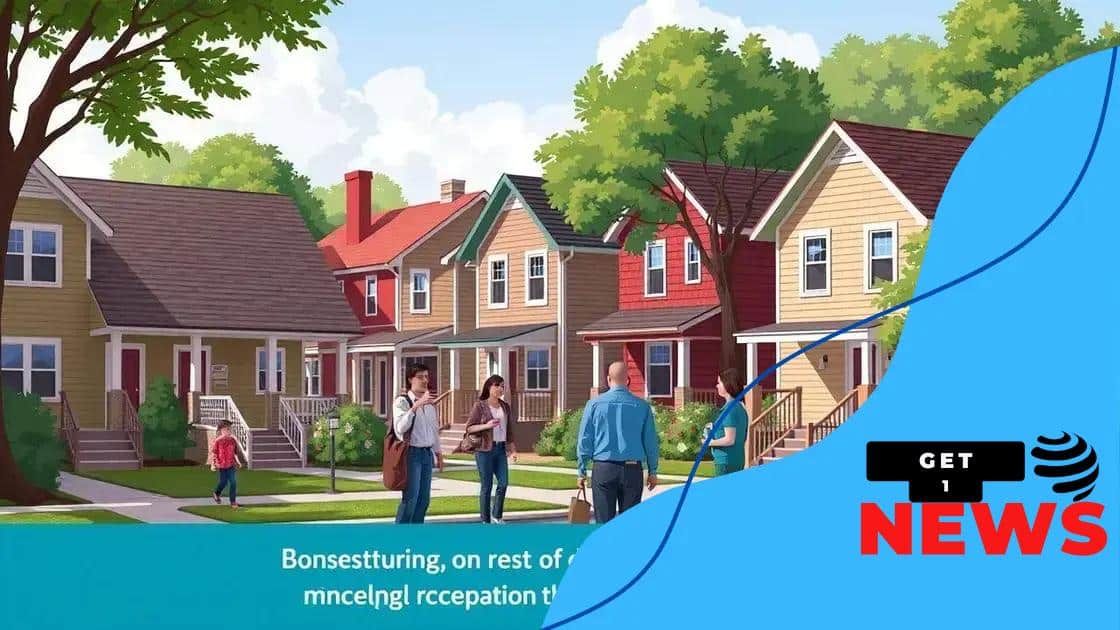How federal government is addressing housing insecurity effectively

The federal government addresses housing insecurity through funding programs, community initiatives, and policies that promote affordable housing, accessibility, and sustainability to help families in need.
How federal government is addressing housing insecurity has become a pressing issue for many communities struggling to find affordable homes. With rising costs and limited availability, understanding the government’s efforts can shed light on potential solutions.
Current policies on housing insecurity
Current policies addressing housing insecurity are crucial for ensuring stable homes for families across the nation. Policymakers are taking a multifaceted approach to improve access to affordable housing. This effort includes various programs and initiatives designed to tackle the root causes of housing insecurity.
Government Initiatives
Recent initiatives focus on increasing funding for affordable housing projects. Federal programs, such as the Housing Trust Fund, allocate resources to build, rehabilitate, and operate rental housing for extremely low-income households.
- Supports for low-income families facing eviction
- Investment in affordable housing construction
- Grants for community development
- Partnerships with non-profit organizations
Additionally, policies advocating for rent control are being explored to stabilize housing costs. Such measures aim to protect tenants from drastic rent increases that can lead to displacement.
Access to Financial Aid
Access to financial assistance plays a significant role in combating housing insecurity. Programs like the Emergency Rental Assistance Program (ERAP) provide funds to assist families unable to keep up with their rent due to unforeseen circumstances. This temporary relief is vital in preventing homelessness and maintaining community stability.
Collaboration with Local Governments
Moreover, the federal government collaborates with local agencies to address housing needs effectively. By focusing on tailored solutions that meet specific community requirements, these partnerships can lead to better outcomes for those at risk of housing insecurity.
With an emphasis on inclusivity, policies are increasingly recognizing the importance of providing diverse housing options. This ensures that everyone, regardless of their financial situation, has the opportunity to secure a safe and stable home.
Programs increasing affordable housing availability
Programs aimed at increasing affordable housing availability are essential for addressing the needs of families struggling to find stable homes. These initiatives often focus on creating new housing options and improving existing ones through various government and private sector efforts.
Affordable Housing Initiatives
Many local governments have launched programs to boost the construction of affordable units. By offering incentives to developers, they can create more housing options for low-income families. These incentives may include tax breaks and streamlined permitting processes.
- Tax credits for low-income housing projects
- Subsidies for construction costs
- Partnerships with non-profit housing organizations
- Support for zoning changes to allow higher density
Another important aspect is the rehabilitation of existing buildings. Older homes and apartments can be updated to meet safety standards while remaining affordable for those in need. This approach often focuses on preserving historic structures while making them livable.
Community Land Trusts
Community land trusts are another innovative solution. They help maintain long-term affordable housing by separating land ownership from housing ownership. This model allows communities to keep home prices down while ensuring that homes remain affordable for future generations.
Federal Support Programs
At the federal level, programs like the Housing Choice Voucher Program allow low-income families to access rental assistance. These vouchers give families greater flexibility in choosing where to live, empowering them to find homes in better neighborhoods without facing high costs.
The combination of these various programs creates a robust approach to enhancing affordable housing availability. By leveraging resources and innovative strategies, it becomes possible to reduce the housing crisis and provide more families with the stability they need.
Impact of federal funding on local initiatives

The impact of federal funding on local initiatives is significant, especially when it comes to addressing housing insecurity. Federal funds help empower local governments and organizations to create effective solutions tailored to their communities. These resources are often directed towards programs that facilitate affordable housing developments and support services for those in need.
Direct Benefits of Federal Funds
Federal funding can dramatically increase the capabilities of local agencies. By accessing grants and subsidies, cities can launch initiatives aimed at combating homelessness and enhancing the availability of affordable housing. This investment leads to improved living conditions for many families.
- Enhanced public services for homeless outreach
- Support for local housing authorities
- Funding for emergency shelters and transitional housing
- Investment in long-term housing solutions
Moreover, federal funds often encourage collaboration among local non-profits, governments, and private developers. These partnerships leverage resources to maximize their overall impact on housing initiatives.
Funding for Sustainable Housing Projects
Investment in sustainable housing projects is another outcome of federal funding. Programs designed to promote energy-efficient and environmentally friendly construction result in both economic and ecological benefits. This practice not only addresses housing scarcity but also contributes to a healthier planet.
Challenges and Limitations
While federal funding is beneficial, it does come with challenges. The process of applying for federal grants can be complex and competitive. Local organizations may experience obstacles in navigating these requirements, limiting their access to crucial resources.
Despite these challenges, the overall impact of federal funding remains positive. By providing the necessary financial support, federal initiatives enable local agencies to create innovative programs that tackle housing insecurity and promote community well-being.
Role of community organizations in addressing needs
The role of community organizations in addressing needs related to housing insecurity is vital. These groups serve as the backbone of local efforts to support families facing housing challenges. They provide resources, advocate for policy changes, and often fill gaps left by government programs.
Direct Support Services
Community organizations offer a variety of programs aimed at helping individuals and families secure stable housing. This support may include emergency financial assistance, which can prevent eviction or homelessness. They also assist with finding affordable housing through referrals and partnerships with local landlords.
- Emergency funds for rent and utilities
- Housing search assistance for families
- Legal aid for tenants facing eviction
- Support groups for those experiencing housing crises
In addition, many organizations focus on education and outreach. They provide workshops that teach financial literacy, tenant rights, and the importance of sustaining a stable living situation. By empowering individuals with knowledge, these groups help foster lasting change.
Advocacy Efforts
Besides direct services, community organizations often engage in advocacy. They work to change policies at the local, state, and federal levels to improve housing conditions. This can involve lobbying for more funding for affordable housing or addressing zoning laws that hinder development.
Building Community Resilience
Through their efforts, community organizations play a crucial role in building resilience within neighborhoods. By creating connections among residents and facilitating community engagement, they enhance social support networks. These networks can be essential for those navigating housing insecurity, as they provide collective strength and resources.
Ultimately, the success of many initiatives related to housing insecurity relies on the dedicated work of community organizations. Their comprehensive approach helps ensure that the needs of vulnerable populations are met and that everyone has access to safe, affordable housing.
Future challenges in housing policy
The future challenges in housing policy are multifaceted and require careful consideration. As communities evolve, new issues related to housing insecurity emerge, which policymakers must address. These challenges include affordability, accessibility, and sustainability in housing.
Affordability Issues
One of the most pressing challenges is maintaining affordable housing. Rising costs in many urban areas are outpacing income growth for low and middle-income families. This crisis forces many to choose between basic necessities and rent, often leading to homelessness.
- Strategies to increase the supply of affordable units
- Exploring rent control and stabilization policies
- Ensuring adequate funding for housing programs
Policymakers must explore innovative solutions to enhance affordability, such as incentives for developers to build lower-cost housing units.
Accessibility Barriers
Accessibility also poses significant challenges, especially for individuals with disabilities and elderly populations. Many existing buildings lack features that accommodate these groups, making it difficult for them to find suitable housing. Enhanced policies are needed to ensure that new developments include universally accessible designs.
Sustainability in Housing Development
Another critical issue is the sustainability of housing developments. As climate change intensifies, housing policies must adapt. There is a growing need to focus on environmentally friendly building practices. Sustainable development not only benefits the environment but also reduces long-term costs for homeowners.
Furthermore, the integration of green spaces in residential areas contributes to community well-being. As urban spaces expand, ensuring access to parks and recreational areas becomes essential for promoting healthy lifestyles.
In summary, the challenges facing housing policy in the future require a comprehensive and adaptive approach. Addressing these issues will take collaborative efforts between government agencies, community organizations, and private developers to create solutions that promote equity, access, and sustainability in housing.
FAQ – Frequently Asked Questions about Housing Insecurity
What are the main challenges facing housing policy in the future?
Key challenges include maintaining affordability, ensuring accessibility for all, and promoting sustainability in housing developments.
How do community organizations help in addressing housing needs?
Community organizations provide essential services such as financial assistance, housing search support, and advocate for policy changes that benefit low-income families.
What role does federal funding play in local housing initiatives?
Federal funding enhances local initiatives by providing essential resources to develop affordable housing and support services that combat homelessness.
Why is sustainable housing important?
Sustainable housing practices help reduce environmental impact and improve long-term living conditions, creating a healthier community for residents.





